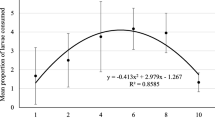Abstract
A method of estimating the weight ofindividual Abgrallaspis cyanophylli (Signoret)without the need for removal from the host plant isdescribed. Using this method, which enables accurateestimations of scale insect weight by measuring lengthand relating it to a previously determined regressionmodel, maximum feeding potential in male and femaleChilocorus nigritus (F.) adults was examined atvarious constant temperatures over the range of 13 to30 °C and at a cycling temperature of 12 h/12 hat 14/30 °C (r.h. in the range of 62 to 68%). Mean daily potential food intake varied from 0.097 mg/day at 13 °C to 1.432 mg/day at 30 °C.However, intake at the cycling temperature was significantly higher than that at constant temperatures (1.98 mg/day). At 15, 20 and 30 °C there were no significant differences between male and female potential food requirements whilst at temperatures in the mid range, there was a considerable increase in female potential voracitywhen compared to that of the males. Maximum potentiallarval food requirement for development at 26 °Cand 62% r.h. in C. nigritus was also estimatedusing the above method. A mean of 16.24 mg of Abgrallaspis cyanophylli (Signoret) was required forlarvae of both sexes to complete development. Thisstudy suggests that C. nigritus would be mostefficient as a biological control agent if used inglasshouses with a mean daily temperature above22 °C.
Similar content being viewed by others
References
Ahmad, R., 1970. Studies in West Pakistan on the biology of one nitidulid species and two coccinellid species (Coleoptera) that attack scale insect species (Homoptera: Coccoidea). Bull. Ent. Res. 60: 5-16.
Foldi, I., 1990. Moulting and scale cover formation. In: D. Rosen (ed), World Crop Pests, Volume 4A. Armoured Scale Insects: Their Biology, Natural Enemies and Control. Elsevier, Amsterdam. pp. 43-54.
Frazer, B.D., 1987. Predators. In: A.K. Minks and P. Harrewijn (eds.), World Crop Pests, Volume 2C. Aphids: Their Biology, Natural Enemies and Control. Elsevier, Amsterdam. pp. 217-230.
Gawande, R.B., 1966. Effect of constant and alternating temperatures on feeding and development of Cheilomenes sexmaculata FB. In: I. Hodek (ed.), Ecology of Aphidophagous Insects, Proceedings of a Symposium held in Liblice, Prague, 27 September to 1 October 1965. W. Junk, The Hague. pp. 63-68.
Hagen, K.S., 1962. Biology and ecology of predaceous Coccinellidae. Annu. Rev. Entomol. 7: 289-326.
Hattingh, V. and M.J. Samways, 1993. Evaluation of artificial diets and two species of natural prey as laboratory food for Chilocorus spp. Ent. Exp. App. 69: 13-20.
Heidari, M., 1989. Biological control of glasshouse mealybugs using coccinellid predators. Ph.D. Thesis, University of London. 372 pp.
Hodek, I., 1973. Biology of the Coccinellidae. W. Junk, The Hague.
Jalali, S.K. and S.P. Singh, 1989. Biotic potential of three coccinellid predators on various diaspine hosts. J. Biol. Contr. 3: 20-23.
Koteja, J., 1990. Embryonic development, ovipary and vivipary. In: D. Rosen (ed.), World Crop Pests, Volume 4A. Armoured Scale Insects: Their Biology, Natural Enemies and Control. Elsevier, Amsterdam. pp. 233-242.
Ponsonby, D.J. 1995. Biological control of glasshouse scale insects using the Coccinellid predator, Chilocorus nigritus. PhD. Thesis, Wye College, University of London. 437 pp.
Ponsonby, D.J. and M.J.W. Copland, 1996. Effect of temperature on development and immature survival in the scale insect predator, Chilocorus nigritus (F.) (Coleoptera: Coccinellidae). Biocontrol Sci. and Technol. 6: 101-109.
Ponsonby, D.J. and M.J.W. Copland, 1998. Environmental influences on fecundity, egg viability and egg cannibalism in the scale insect predator, Chilocorus nigritus (F.) (Coleoptera: Coccinellidae). BioControl 43: 39-52.
Samways, M.J., 1984. Biology and economic value of the scale insect predator Chilocorus nigritus (F.) (Coccinellidae). Biocontrol News and Information 5: 91-105.
Samways, M.J. and B.A. Tate, 1984. Sexing of Chilocorus nigritus (F.) (Coccinellidae). Citrus and Subtropical Fruit Journal, 607: 4-5.
Samways, M.J. and S.J.Wilson, 1988. Aspects of the feeding behaviour of Chilocorus nigritus (F.) (Coleoptera: Coccinellidae) relative to its effectiveness as a biocontrol agent. J. App. Entomol. 106: 177-182.
Smith, B.C., 1966. Effect of food on some aphidophagous Coccinellidae. In: I. Hodek (ed.), Ecology of Aphidophagous Insects, Proceedings of a Symposium held in Liblice, Prague, 27 September to 1 October 1965. W. Junk, The Hague. pp. 75-83.
Tirumala Rao, V., A. Leela David and K.R. Mohan Rao, 1954. Attempts at the utilisation of Chilocorus nigritus (F.) (Coleoptera: Coccinellidae) in the Madras State. Indian J. Entomol. 16: 205-209.
Yinon, U., 1969. Food consumption of the armored scale lady-beetle Chilocorus bipustulatus (Coccinellidae). Ent. Exp. App. 12: 139-146.
Zar, J.H., 1984. Biostatistical Analysis, 2nd edn. Prentice-Hall, Englewood Cliffs, New Jersey.
Author information
Authors and Affiliations
Corresponding author
Rights and permissions
About this article
Cite this article
Ponsonby, D., Copland, M. Maximum feeding potential of larvae and adults ofthe scale insect predator, Chilocorus nigrituswith a new method of estimating food intake. BioControl 45, 295–310 (2000). https://doi.org/10.1023/A:1009953005065
Issue Date:
DOI: https://doi.org/10.1023/A:1009953005065




